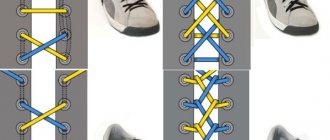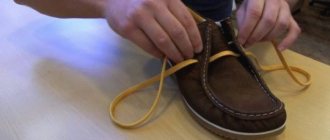| 18.06.2015 |
Tying shoelaces, despite its simplicity, is a fairly important human skill. Disabled children are considered adapted to life if they can perform this rather complex manipulation. Every person has shoes in their wardrobe that need to be laced - and there are different ways to do this.
Laces can play not only a functional, but also an aesthetic role. Moreover, each type of shoe requires a certain technique for tying laces. In total, there are 3 methods of tying shoelaces (the rest are derivatives of them), which were systematized by Jan Figgen, a fashion lover and connoisseur.
The first method is good for sports shoes, sneakers, boots, etc. In principle, this can be ordinary classic lacing, which allows you to securely and firmly fix the ankle and increase tension in a certain area. The second method, straight lacing, will look elegant on classic men's shoes and boots. The third method, the cross method, is ideal for youth sports shoes with flat, wide laces. There are many varieties of this method, and each of them looks stylish and modern.
classic lacing
straight lacing
cross lacing
Nothing is more annoying than a shoelace coming undone at the most inopportune moment. If you don’t tie it, there is a danger of stepping on it with your other foot. How to tie your shoelaces when you are walking in a crowd of people and carrying bags of groceries in both hands? There are times when it is simply not physically possible to tie a shoelace, for example, during a bike ride, on a hiking trip, or at a running competition. If you want a knot that is secure but easy to untie by hand, there are different knot tying techniques that you can use in addition to traditional bows.
How to tie shoelaces so they don't come undone
The good thing about a straight academic knot is that it cannot untie itself, but it is easy to untie it with your hands even when wet. To tie a reliable knot, it is necessary to perform movements on both the right and left ends of the lace strictly from top to bottom or from bottom to top. To tie a strong knot, you need:
1) the working part of the lace must be at least 15 cm. Make a loop from the right half by folding the working part in half with the letter U, the rounded part to the right, the ends to the left. 2) then pull the left half of the lace through as follows: the lace goes around the bottom strip of the U-shaped design on the side of the shoe 3) then, in an upward motion, pull the left half of the lace to the top strip of the U-shaped construction of the right end of the lace. 4) the left end of the lace should move from top to bottom around the loop. 5) grab the right and left ends and tighten the knot tighter
Lacing for sports
Athletes and extreme sports enthusiasts know how to tie shoelaces correctly under constant loads. This skill is not just fun, it is a way to prevent injury and maintain good health even after tiring activities.
For running
Runners most often choose cross lacing, complementing it with a loop lock. The direct method of tying sneakers is also popular among track and field athletes.
For regular sports, it is better to choose sneakers with holes arranged in a zigzag pattern. These shoes provide good support for your feet and make training easier.
For hiking
There is also a special lacing technique for hiking. Procedure:
- Having pulled the ends into the first row from the inside, the right eglet must be threaded vertically into the third row, and the left into the second.
- The right end is moved in a horizontal strip to the left and vertically inserted into the fifth hole.
- The left end on the right side goes vertically into the fourth hole, then moves to the left and is threaded into the sixth.
For racers
The racing version features a unique knot in the middle of the racing boots. First, the lace is passed diagonally and comes out of the lower left and upper right holes. Then the lower end rises in a zigzag towards the center, and the upper end falls.
How to tie a knot on shoelaces
The furrier's knot is reliable and durable, but it is easy to untie by hand:
1) from the right part of the lace, make a loop with the working end at the bottom, the main part of the lace at the top, the end of the lace faces to the right (step 1) 2) Pass the left half of the lace through the formed loop, moving from the inside of the loop outward to the left side (step 2) 3) wind the working end the left half of the lace under its main part (as in the case of the right lace) and direct the end to the right (step 3) 4) now we take together both ends of both the right and left halves of the lace and pass them through the middle of both loops (step 4) 5) pull both ends forward and tighten the tight knot (step 5)
Knots for tying a cross rope
There is no specific technology for tying knots (their number, shape, size). It is worth using the method that is convenient, easy to implement, reliable and durable. There are many types of such nodes.
Some of the simplest methods are the following nodes:
Straight
| Step 1. The two ends are intertwined once. | Step 2. Next they are placed under each other. | Step 3. The ends should be parallel to the main rope and tightened. |
Mother-in-law
| One tip bends into an incomplete loop. The second part is threaded through a loop in the floor from above, going around its upper part. It is brought out under an incomplete loop. The ends are located on different sides of the knot, diagonally. The ends are tightened. |
You can use slightly more complicated options:
Flat
| Step 1. A loop is made on one side. The second part is superimposed on it. | Step 2. Bringing the loop to the end, then passing through the loop. |
| Step 3. Drawing from above itself, it comes out of the loop from below. | Step 4. By pulling both ends, the knot is tightened. |
The ends of the knots can be processed using a lighter (burned) to ensure the reliability of the bundle.
How to tie shoelaces without a bow
The surgical knot is an improved modification of the direct knot. It was invented specifically for tying surgical sutures, and the knot is designed to withstand heavy loads. He practically cannot untie himself, but this can be easily done with the help of his hands. Such a knot is indispensable if you are going on a hike and you do not have the opportunity to stop and tie a loose lace. The technique for doing it is as follows:
1) take the right lace and make a loop from its end, passing the working end from top to bottom into the loop, but do not tighten it. The end faces left.
2) now we pass the left lace into the holes formed between the loop and the working end, as shown in the figure. The working end of the left lace should point to the left.
3) you should get two identical loops intertwined with each other.
4) take both ends and tighten the knot tighter
There are many types of knots, but these are the strongest and most reliable. You can safely tie them on during a cycling marathon, a hike in difficult conditions, or a mass race.
What types of laces are there?
It happens that boots wear out much more slowly than laces. And frayed and stained strings, and even tied in a bow, can greatly spoil the appearance of even luxury shoes, making them sloppy and untidy. In this case, the question arises of choosing new ties.
What types of laces does the range offer?
- Flat
ties are perhaps the most common type of ties. Used in sports sneakers and casual sneakers. Reliably fix the shoes on the foot. - Round
- most often seen on classic models with a small number of lacing holes. They are used more as an accessory than as a fixation element. - “Hickies”
or
“Lazy Shoelaces”
are bendable thin strips of plastic with rivets. With them you don't even have to tie your shoelaces! They look great on bright sports shoes and sneakers. - LED
- appeared on the wave of popularity of sneakers with luminous soles. To this day they are quite a popular, albeit peculiar, shoe accessory. among young people whose life is connected with parties. There are several types of luminous laces - round, battery-powered, and flat, impregnated with fluorescent paint.
Attention!
Round laces should not be pulled too tight. Because of their shape, they will put pressure on blood vessels and cause a lot of discomfort when walking.
Among other things, pay attention to the material from which the laces are made.
The market leader is synthetics, since it is the most wear-resistant and non-staining, but besides it, you can find ties from:
- Leather (natural and artificial) – for lacing classic shoes.
- Cotton and jute - for sports and casual models.
The video explains what lazy shoelaces are:
How to tie a bow on shoelaces
Even kindergarten children can tie a bow on their laces, but how can you make sure it doesn’t come undone? The technique is simple and understandable for everyone:
1) tie a regular knot of two laces (step 1)
2) start tying a bow in the usual way (step 2), but, skipping one loop inside (step 3), start skipping the second one in exactly the same way (step 4)
3) after missing, pull the “ears” of the loops (step 5)
4) correct the knot (step 6)
How to tie shoelaces correctly
Sneakers are the most versatile type of footwear. They can be worn with casual clothes, jeans, sportswear and even a dress. Therefore, it is necessary to master at least several methods of lacing sneakers in order to tie the laces in a special way for each type of clothing.
Method 1.
Lattice lacing type - “lattice”. It looks especially impressive on wide laces.
Method 2.
Lacing type Hash-“confusion” (photo 14). This is a cross-shaped way of tying shoelaces.
Useful tips for teaching children how to lacing
Do you want to teach your child to tie his shoelaces? We advise you to consider the recommendations below:
- the optimal age for learning this skill is from 4 to 6 years;
- since girls are usually one step ahead of boys in development, then if your daughter shows interest in lacing, do not interfere with her desire and try to take the “young fighter course” as soon as she expresses a desire for this;
- Talk to your child about the ability to tie shoelaces, without which the child will not become an adult. We can say that when he goes to school, this skill will come in handy more than once. During the conversation, immediately demonstrate how easy it is to lace your shoes;
- New information and skills are best learned through play, so it’s worth using toy lacing. Similar games in the form of animals, fruits or vegetables can be offered from 2 years of age. This will help in developing fine motor skills and learning the skills of threading a thread twisted several times through a hole;
- make sure that your baby clearly knows where the left and where the right foot is, and first choose only 1 lacing method so that he does not get confused in them;
- during training, repeat the same comments, this is necessary for the child to more quickly assimilate information;
- help tie shoelaces more conveniently if an adult is holding the child in his arms or is to the left or right of him;
- if the child does not want to learn this simple skill, do not insist or punish, so as not to provoke an aversion to lacing;
- Children learn best by example, by imitating adults. When they see you tying your sneakers, they become interested in the process and one day they will ask you to teach them how to tie their shoes beautifully. After this, you can sit down with your baby, talk verbally and clearly demonstrate that a loop can be made from 1 cord, and the 2nd cord is not pulled into the loop all the way (the “bow” method);
- when the child begins to master lacing, you can organize competitions, involving all family members in participating;
- To help your child practice more often, from time to time ask him to help tie the laces on your sneakers, complaining, for example, about back pain. Many children happily take care of their beloved parents; it is only important to praise and encourage them more often;
- You can make a simple lacing toy with your child. To do this, take a sheet of thick cardboard, draw shoes on it, make holes in them with an awl and thread the laces, which you will then learn to tie. You can use a doll or soft toy for training and lace up toy shoes;
- Another good idea is to capture the learning process on video so that years later you can remember how you taught your baby how to tie his shoelaces beautifully.
Whatever methods you adopt, we hope that this article was useful and you were able to learn a new way to tie shoelaces or teach your child this simple art.
How to tie shoelaces on sneakers
This type of lacing looks impressive on multi-colored laces. Tie two laces of different colors with a surgical knot from the inside between the bottom hole and the one next above it on the left.
Method 5.
Lacing type Bi-colour - “double color”. The name speaks for itself: it is necessary to use two laces of contrasting color.
1) pass one lace (red) in front through the lower parallel holes, and pass the second (orange) in the same way through the second parallel holes from the bottom.
2) from behind, pass the red lace into the third hole from the bottom, running perpendicular to where the lace came from. Insert the red cord in front from the right hole into the parallel left one.
3) do the same with the orange cord, just pass it through the fourth hole from the bottom.
4) do this the required number of times depending on the number of holes.
5) tie the knot from the inside. Lacing will look impressive and stylish.
Straight lacing
Straight lacing, also called rectangular, has a neat look. This is a universal option that is relevant for any shoes, regardless of style and purpose.
Straight lacing with short ends
Straight lacing begins from the toe - the usual horizontal line of the lower two holes. Tying steps:
- One end of the lace is threaded from the inside into the same side of the second row, then shifted to the other side, forming another parallel.
- The second end does the same in the third row.
- Alternating straight lines, we get rectangular lacing.
Two-tone straight lacing option
It is possible to lace shoes using the straight lacing method traditionally or diversify them using multi-colored laces. To do this, you need to knit halves of different colors, thread them into the bottom two holes and alternate parts of the lace through the row.
Try to ensure that the loose ends that remain after lacing are not too long, otherwise you will end up with an awkward bow or knot that will ruin the appearance of the shoes.
How to tie laces on sneakers
This lacing method is applicable to plain laces.
Method 6.
Lacing type: Double back. It looks like a simple method, but in fact it has its own nuances, and the lacing turns out to be very tight, thanks to which the foot will be firmly fixed in the shoe.
1) select the longest laces, determine their middle. Pass the lace through the second parallel holes from the top on the front of the sneaker so that the middle of the lace is exactly between the holes.
2) the right working end is indicated in red, the left – in orange. Insert both ends of the lace from top to bottom into a parallel hole, but through one hole down.
3) do this until the second holes from the bottom. Then pass the right lace from inside the sneaker into the hole below, and the left one in the same way.
4) now pass the laces from bottom to top into a parallel hole, but through one hole to the top.
5) do this until the outermost parallel holes.
Method 7.
Lacing type: Criss Cross. This method is one of the most popular. The laces are inserted into the hole of the sneaker from the inside, pulled out and reinserted from the inside of the opposite hole. As a result, the sneaker itself is fixed, not the foot.
Basic types of lacing for sneakers and sneakers
Our expert will talk about a variety of lacing methods, the purposes of which are different - following fashion, increasing functionality (for example, reducing the length of laces, tying knots so that the ends of the bow do not catch on the bicycle frame, etc.). Don't know how to tie your shoelaces beautifully? Our article will help you try new methods in practice.
Zigzag
Even a preschooler can master Zigzag. You must first thread the cord through the lower eyelets so that the 2 ends “look” outward. Place the ends in an X shape and push them up - this should be done for each pair of eyelets. Finally, 2 laces are tied with a bow.
Diagonal lacing
Expert opinion
Zakharov Igor Vyacheslavovich
Consultant at a furniture store. 5 years of experience.
Thread 1 cord through the eyelets at the bottom from the inside, and the 2nd from the outside. The side that has passed through from the inside will be visible on the shoe, while the other side will be hidden. The length of the laces should be the same.
Insert the “visible” end into the eyelet from the other side: it should enter from the outside. Thread the 2nd (invisible) end through the next eyelet from the other side from the inside. In this case, the invisible side is located on the outside of the sneaker.
Crisscross
A simple method that is known to everyone and is suitable primarily for men's boots.
Pass the cord through the eyelets at the bottom from the wrong side and bring it out to the front side, trim the length of the laces. Pass 1 end through the next eyelet on the other side. Repeat the same with the 2nd lace, you will see that they intersect. Continue to the end, make a knot and a bow.
Straight lacing
This option is also called “rectangular lacing”; it does not have laces inside the sneakers, which are braided diagonally. First, the cord is passed through the eyelets at the bottom and pulled inward from 2 ends.
One of them is lifted upward from the right; it will come out of the grommet from above, then it should be threaded into the grommet on the left. 2 ends are lifted up and brought out through 1 eyelet, pulled to the other side and pulled higher.
They lace in this way until the eyelets run out. The 2nd end is brought out through the remaining eyelet from above.
Reverse lacing
Pass the lace through the 2nd pair of rings at the top, leading it inside the shoe. Cross its ends and push them inside the 4th pair of rings. Continue lacing the 2 ends at the same time, cross the laces at the very bottom and thread them into the 2nd pair of holes at the bottom. Repeat the passage of the laces along the remaining rings.
Sawtooth lacing
The cord is inserted into the eyelets at the bottom by moving from the outside to the wrong side. 1 lace will run parallel to the floor along all the rings. The 2nd cord is threaded obliquely, skipping 1 eyelet. Continue doing this until 1 end of the lace ends.
European lacing
1 cord is threaded from the outside into the eyelets at the bottom. 1 end of the lace must be threaded through the lacing eyelets from above, the 2nd side - 1 hole higher. Do this alternately until you run out of rings.
Lattice
First, you need to insert the laces into the 1st eyelets from the inside, then make a cross out of them and insert them into the 4th eyelets from the outside. Insert the 1st tip into the 2nd eyelet from the inside on the same side, and then from the outside into the 5th on the second side.
Then you need to insert the 2nd tip from the inside into the 2nd eyelet on the same side, pass it under the lace of the 1st cross and insert it from the outside into the 5th eyelet on the 2nd side.
Then you should thread the 1st tip of the lace into the 3rd eyelet in the inner part on the same side. Insert the cord over the 1st cross and under the 2nd and insert into the 6th eyelet on the 2nd side on the inside. Likewise with the 2nd end. At the end, make a knot.
Web
Thanks to this type of lacing, the sneakers will fit snugly on your feet. First, you should insert the laces from the inside into the 2nd eyelets and thread them from the outside into the 1st, without changing the side. Then make a cross out of them and pass them from the inside through 3 eyelets. A cross will be visible above the 1st line of laces horizontally.
Then you should push them under the 1st loops, cross them and insert them from the inside into the 4th eyelets - the new cross will be located above the 1st. Then you should thread them under 2 loops and insert them from the inside into the 5th eyelets on the 2nd side, and then in the same way into the 6th.
How to tie shoelaces
Method 8.
Straight lacing type. Applicable only to shoes with an even number of holes.
1) one of the ends (blue) is inserted into the lower right hole from the outside to the inside and, passing from the inside through the entire row, comes out in the top hole of the same row.
2) the second half of the lace (yellow) is inserted from the outside into the lower left hole, brought out of the hole next to the top, then passed from the front into the right hole parallel to this hole.
3) then, along the outside, the “yellow” part is inserted from the hole above, comes out of it and is passed from the outside into the parallel left hole.
4) so the lacing is carried out to the top hole. The difficulty is to determine the required length of the working part of the lace. But the result looks neat and impressive.
6-hole lacing methods
This is where you can really “go wild”! When you have mastered the methods described above, get down to unusual and intricate lacing. Believe me, she is worth all the effort!
"Store lacing"
- Pass the lace through the bottom holes from the inside out.
- Now pass both ends into the upper holes on their sides from the inside.
- Each end of the lace is looped onto the adjacent end and pulled up again into the next hole.
- Repeat these steps all the way to the top.
How to tie laces on high top sneakers
Method 9.
Lacing type Spider Web Looks impressive on high shoes or boots when two multi-colored laces are used.
1) tie two different colored laces together and pass them through from the inside so that the knot is between the second holes from the bottom. 2) pass the right lace (blue) and the left lace (yellow) from the second hole from the top to the first hole on the outside. 3) now, from the inside, pass the blue lace from the bottom hole into the third hole from the bottom in the parallel row. 4) do the same with the yellow cord. 5) Now wrap both laces separately around the bottom stitches of the lace and insert into the fourth hole from the bottom, located on the parallel side. 6) do this with both laces until the end of all holes.
Method 10.
Bow Tie The laces need to be short, but an even number of holes in the sneaker is desirable.
1) the middle of the lace is determined, it should be between the lowest holes. 2) then, from the inside, both halves of the lace are inserted into the parallel holes second from the bottom and crossed on the front side of the sneaker. 3) lacing the remaining holes is carried out in the same way.
Unusual knots
Not only the lacing style, but also the knots themselves can look impressive.
Aina Figena knot
A fast and reliable option, the result is similar to the classic “bow”, but will be more durable.
Surgeon's knot
Another way to secure your shoes tightly. Suitable for travelers who are on the road for a long time.
Double slip knot
Such a knot begins to be tied like a regular bow, but gradually the pattern becomes more complicated, making it more durable.
You learned how to tie your shoelaces correctly and do it in unusual ways. You can use this in your image or teach others how to make fashionable patterns from laces.
Page content:
Many people lace up their boots and other footwear the same way they have been accustomed to doing since childhood. However, there are several dozen lacing methods.
Sometimes you want to try new ways, diversify your life and add some “zest” to your wardrobe. In this article we will share information on how to beautifully tie your shoelaces with a bow to look original.
When you start experimenting in this area, be prepared to increase your popularity among friends and increase attention to your person among others.
How to tie laces on boots
Method 11.
Army - "army". It's like the reverse side of a Bow Tie lacing. This is an army type of lacing among soldiers of Western European armies.
Method 12.
Train Track - “railroad track” (photo 24). This lacing requires large holes because the lace goes into one of them several times.
Method 13.
Zipper - “fastener”. Suitable for lacing roller skates because this lacing is strong and reliable.
Roman
The lacing received its name due to the alternation of Roman numerals I and X. It is suitable even for six pairs of eyelets.
- Here the tie is inserted from the side on the left into two holes, crossed to create a ten.
- Then the end that passes through the lower hole on the right is threaded into the third right hole and the third left one. It turns out to be one.
- Next, it is transferred to the fourth left grommet for the crosshair.
- The second end goes through the second hole on the left and immediately goes into the fourth hole on the right to cross and create the second ten.
- Then the ties are pulled out for fixation.
How to tie your shoelaces beautifully
Method 16.
Twistie - “twist”. Looks good on thick round laces in two contrasting colors.
Method 17.
One Handed Convenient to use when the other hand is injured. The lacing at the bottom will be slightly looser than at the top.
Method 18.
Double Cross Lacing is difficult to do, but the result is very strong and reliable. The method is good for traveling in the mountains and riding bicycles over long distances.
Large size swimsuits 2015 Fashionable women's raincoats spring-summer 2021 Fashionable suits for boys fall-winter 2018-2019 Fashion for obese women spring-summer 2016 Fashionable women's tweed coats 2016 How to choose a wedding dress based on your figure
Beautiful methods of lacing ends inward
Many amateurs often get their shoelaces untied. To prevent this from happening, there are several proven methods, thanks to which you can not only lace your shoes securely, but also hide the ends inside.
Hidden node
A popular way to tie shoelaces on sneakers without a bow. Step by step technique:
The secret of this method is that the bow is hidden in the inner side of the loops, and only the created pattern is visible in the frontal area.
Tangled Trail
It is considered one of the most difficult methods, but it looks very unusual in appearance. Step by step description:
Just a few minutes and you will look new and very attractive. This method of tying will be useful for those who are used to attracting attention to their person.
Crisscross
A simple method that is especially suitable for . The technique is as follows:
This method is perfect for both men's and women's shoes.
Without a bow
An ideal method for those whose shoelaces constantly come undone. Step by step description:
- Take the left end of the aglet and insert it into the left hole on the outside of the shoe. With the right end, do the same only on the opposite side;
- Perform these movements one by one; the ends of the laces can be tied into a knot on the wrong side.
The “No Bow” method allows you to beautifully hide the laces inside the shoes.
With three holes
This method visually lengthens short laces. Step by step description:
- Take and thread the eglet through the bottom eyelets, leaving the ends inside the shoes;
- Pull the eglet vertically through the next pair of holes;
- Cross the ends and insert them into the next holes;
- Continue doing the same steps until the end. Tie a knot inside the shoe.
The “Three Hole” method is best used only for sneakers with short laces, as well as boots, boat shoes, etc.
Straight lacing
Straight lacing will make the shoes attractive in appearance and will make you stand out among your friends. Step by step description:
Straight lacing will look good on high-top sneakers.
Lace-up with hidden knot
When the knot is hidden inside the shoe, it looks beautiful and attractive:
- It is recommended to tie sneakers using the straight lacing method. The right end should be longer than the left;
- The left part of the lace should be left unlaced, and the right part should be brought to the top of the shoe;
- Pass both parts inside the shoes and tie the laces.
This method is ideal for tying the laces on sneakers so that they are not visible. As practice shows, lacing with a hidden knot is especially popular among athletes.
The video below shows an original method of super-fast lacing without any knot.
Web
The “Spider Web” method has become especially popular recently. Visually, this lacing looks amazing and attracts the attention of passersby. Step by step technique:
On the Internet you can find many photos and videos where users share their secrets of lacing sneakers.
Chess board
This method will require two laces of different colors (for example, orange and blue). To get a good result, you need to practice a lot. Step by step technique:
This type of fashionable lacing is especially often used by skateboarders and cyclists to emphasize their individuality.
A knot on shoe laces seems like a small thing, but if you do it differently than we are all used to, it turns into some kind of art! Lacing master Ian Fieggen describes as many as 17 different ways to tie your shoelaces on his website!
Let's look at each of them!
All diagrams of the nodes shown in the pictures are facing you, as if you were looking at your leg. The laces are painted in different colors for better orientation in the knot tying pattern.
Ian Fieggen
Make a loop with each end of the lace and simultaneously bring them through each other, thereby instantly forming a knot.
Safe node Ian Fieggen
Make two loops and put them through the “hole” in the middle.
The finished knot, in addition to its strength, is also beautiful, symmetrical, with two curls of lace wrapped around it.
Standard knot or "Around the tree"
This is roughly how people learn to tie shoelaces in childhood; this is the most common way to tie shoelaces.
Double loop knot (Bunny Ears knot)
Make a loop from both ends (they look like ears), and simply tie them into a knot. In my opinion, in Russia it is this, and not No. 3, knot that is the most common (their tying results are completely the same).
No matter how simple this knot may seem, its execution is incorrect, such a knot is unbalanced and your shoes will come untied all the time (“Granny’s knot”).
But this position is correct, the knot on the laces will hold tightly:
Two-step knot
The first step is to tie a knot by pulling out the yellow end of the lace. After this, you need to make a loop out of it and tie it with the blue end of the lace, this will be the second step.
This knot is asymmetrical, therefore it is not very beautiful, but it is quite strong, because even if you accidentally pull the end of the lace, you will not untie the entire knot at once, but only its second half.
Surgeon's knot
Common, but not the best of reliable nodes. First, proceed as when tying a standard knot on boots, but wrap the yellow end of the lace around the knot one more time.
It is better to use a reliable knot No. 2 for tying shoelaces; it is symmetrical, therefore more beautiful and safer.
Turquoise turtle knot
The name of the knot arose from the name of the shop where shoes were tied in this way.
You begin tying the Bunny Ears knot, but thread the yellow loop through the middle hole one more time.
Best bend
Another option for a reliable node
FreedomKnot™
There's even a whole funny website dedicated to this node.
Tighten the Loop Knot
Performed based on the first or third node.
We insert the loops one into the other, now pull simultaneously on the yellow loop and the blue tip of the lace.
Double knot
We tie any knot on the laces, leave the loops longer, and then tie them together again, as shown in the figure.
Result:
Double knot Ian Fieggen
Tie knot number 1, but leave longer loops, and then repeat the same operations again
By repeating the operations more than twice, you can get wood from laces right on your shoes!
Crossed knot Ian Fieggen
The loops are also threaded into each other, but a little differently than in a regular Ian Fieggen knot (pay attention to the direction of the ends of the laces!)











